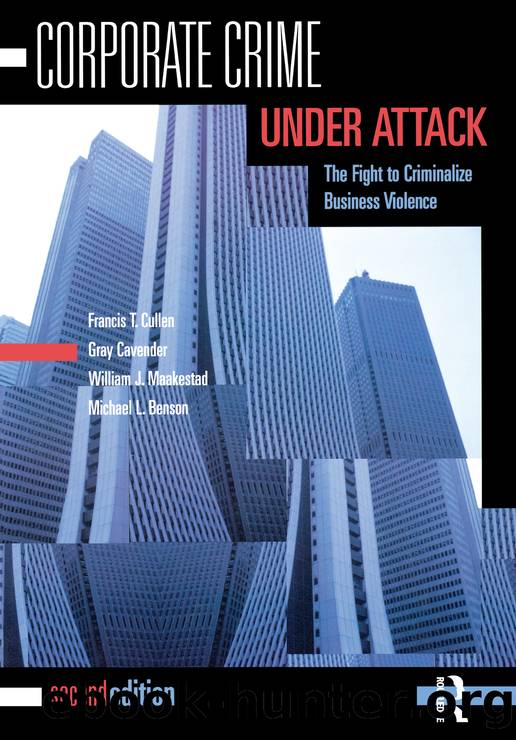Corporate Crime Under Attack: The Fight to Criminalize Business Violence by unknow

Author:unknow
Language: eng
Format: epub
Tags: Social Science, Law Enforcement, Political Science, Criminology
ISBN: 9781317523666
Google: zyygBAAAQBAJ
Goodreads: 23318751
Publisher: Routledge
Published: 2006-10-01T00:00:00+00:00
Conclusion: Closing the Debate
Nearly five months had passed since the tragedy on U.S. Highway 33; nearly four months since the grand juryâs indictment of Ford. In the meantime, amid the flurry of research and the proliferation of memoranda, 1978 had passed into history. With the new year came the retirement of Judge Charles E. Hughes, the nearly 70-year-old Elkhart Superior Court judge who had had the responsibility for handling the Pinto case from the beginning. After having convened the grand jury, issued the warrant, and allowed the parties a generous period in which to prepare their pretrial arguments, Hughes was due to retire on January 1, a date that had been set before his involvement in the case. Slated to succeed the highly respected Hughes was Donald W. Jones, a former Elkhart Court judge who had been elected to the Superior Court judgeship in November 1978. The youthful Jones, who had launched his legal career as a public defender, took over with a reputation as a thorough researcher and an excellent communicator. Because the adversariesâ final memoranda in support of their positions had just been filed in the Superior Court, Jones would have no grace period in which to cut his new judicial teeth on less exceptional and lower-profile legal disputes. Instead he would be faced immediately with making a pretrial decision that would be reported across the country by the news correspondents who were now standing vigil at the Elkhart County courthouse.
Judge Jones heard two hours of oral arguments, during which Ford (represented primarily by Roger Barrett of Mayer, Brown, and Platt) and the prosecution (represented by Cosentino, Berner, and Kiely) summarized the legal positions stated in their briefs. The judge spent the remainder of January 1979 studying the many issues that had been raised by the motion to dismiss. Meanwhile, the adversaries waited eagerly for some sign that a decision had been reached. The members of the prosecution team felt highly vulnerable because they knew that Judge Jones could throw the case out of court at any time if he was persuaded by any one of Fordâs numerous arguments.116 Considering the thousands of hours that had been donated to the cause over the past four months, the lawyers, professors, and students found this possibility too painful even to consider.
On the other hand, the Ford staff was disconcerted by the idea that the multinational company might actually be forced to stand trial for three counts of reckless homicide. The possibility of a trial must have appeared significantly more real than it had several months earlier. Before the indictment, according to both Cosentino and Berner, Ford representatives privately seemed âamusedâ by the prosecutionâs corporate homicide theory, although they were by no means unconcerned that it had been brought to bear against their company.117 Nonetheless, the legal staff that the company had amassed in preparing its full-scale attack on the indictment made it perfectly clear that the case was no longer âamusingâ to Ford management, if indeed it ever had been.
On
Download
This site does not store any files on its server. We only index and link to content provided by other sites. Please contact the content providers to delete copyright contents if any and email us, we'll remove relevant links or contents immediately.
The Borden Murders by Sarah Miller(4213)
The Secret Barrister by The Secret Barrister(3591)
Police Exams Prep 2018-2019 by Kaplan Test Prep(2466)
Coroner's Journal by Louis Cataldie(2404)
The Splendid and the Vile by Erik Larson(2327)
Terrorist Cop by Mordecai Dzikansky & ROBERT SLATER(2024)
A Colony in a Nation by Chris Hayes(1858)
My Dark Places by James Ellroy(1856)
The Art of Flight by unknow(1784)
Black Klansman by Ron Stallworth(1730)
A Life of Crime by Harry Ognall(1660)
Objection! by Nancy Grace(1649)
The New Jim Crow by Michelle Alexander(1620)
Anatomy of Injustice by Raymond Bonner(1593)
Whoever Fights Monsters by Robert K. Ressler(1560)
Invisible Women by Caroline Criado Perez;(1558)
American Prison by Shane Bauer(1542)
Obsession (The Volkov Mafia Series Book 1) by S.E Foster(1523)
A is for Arsenic: The Poisons of Agatha Christie (Bloomsbury Sigma) by Kathryn Harkup(1489)
